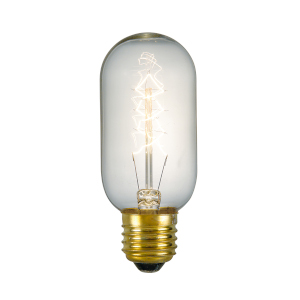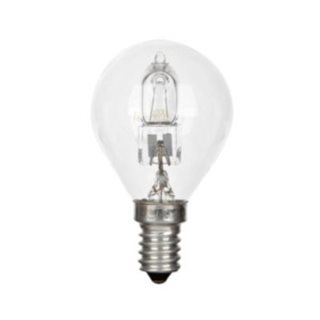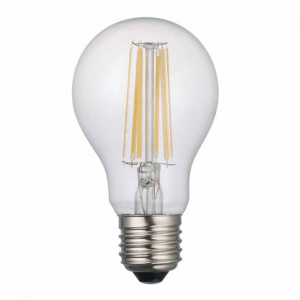How light bulbs work
 Tungsten Incandescent
Tungsten Incandescent
Often termed the “Normal” bulb, now being phased-out due to its’ high energy requirements. By far the simplest of all bulbs, it passes an electric current through a tungsten filament (thin wire), the resistance of the wire causes it to heat up to the point where it glows brightly. Initially the glass bulbs held a vacuum to prevent oxidisation of the filament wire, but later an inert gas was used for safety, cost and improved filament lifespan (by absorbing heat from the filament).
The properties of the bulb are:
- The filament has quite a random life span depending on the quality of the filament. If the filament is thinner in some places then “hot-spots” are formed that can glow brighter but tend to melt (and evaporate) much faster causing the filament to break, stopping the bulb from working.
- As mentioned above the high energy requirements. The bulb works by applying current to a thin wire until it is near melting point. It’s no surprise that a lot of heat is produced in this process. Typically only 2-3% of the electrical energy supplied to the bulb is transformed into light.
- Slow evaporation of the filament causes “soot” to form on the inside of the glass bulb dimming the light.
Halogen Incandescent
The halogen bulb is similar to a standard incandescent bulb, but instead of using an inert gas inside the bulb, it uses a halogen gas that gives the bulb some improved properties. A chemical process causes the evaporated tungsten to be re-deposited onto the filament improving lifespan and causing no “soot” to form on the inside of the glass bulb.
 The properties of the bulb are:
The properties of the bulb are:
- Improved life span and consistent light output.
- High energy requirements similar to the standard incandescent bulb.
- Chemical process requires higher temperature, requiring a more expensive glass/quartz bulb and more energy loss though heat.
Fluorescent
Fluorescent lamps have been available as tube lights for many years however in the last decade they have also become common as light bulbs. The tubes are filled with a low-pressure mix of mercury and an inert gas. When a voltage is applied across the tube, electrons begin to travel though the low-pressure gas forming a plasma. In the plasma the electrons impart energy in to the mercury atoms, the mercury then releases the energy in the form of photons (light). Unfortunately the photons released by the mercury are ultraviolet (black light) and cannot be seen by the human eye. To solve this, the inside of the glass tube is coated in a phosphor powder which glows when the ultra violet light hits it.
The properties of the bulb are:
- More efficient than incandescent bulbs by a factor of 4
- Electrical properties of the plasma vary with current/heat requiring the current to be limited to prevent overloading. This is done using an electrical circuit called a ballast, when the ballast develops a fault, it causes the on-off flicker often associated with fluorescent lamps.
- Also due to the variable properties of the plasma the light output changes, starting dimmer then brightening after 1-10 minutes often termed the “warm-up” period.
 LED
LED
The latest technology is the Light-emitting diode based bulbs, LEDs have also been around for a long time but only recently has the cost of LEDs (of sufficient brightness and colour) reduced enough to be competitive in the light bulb market. LEDs work in a way similar to the fluorescent tubes, by forcing energy into atoms then the atoms releasing the energy in the form of photons but there is no plasma with the LED method. LEDs are formed using semiconductors, where a junction is formed on a semiconductor by doping with impurities. Some impurities remove electrons from the semiconductor atoms and some create more electrons. In an LED, when a voltage is applied across the junction, electrons are continually absorbed into atoms that are missing electrons. As the electron is absorbed, energy in the form of photons is released. The colour of the light emitted depends on the impurities used to dope the semiconductor.
The properties of the LED bulb are:
- Most efficient technology (up to 10 times lower energy requirements than incandescent)
- A range of colours, including warm white (yellow tint) and cool white (blue tint)
- No “warm-up” period
- Long Lifetime (light will fade but very, very slowly)
- Directional light source (patterns shown in light shades)
- Electronics required to convert Mains AC supply into lower DC voltage required by LEDs
- Expensive compared to other bulbs
Caveats
When it comes to lamps like CFL and LED, where electronics is used to modify the mains voltage to a compatible form (high-frequency for CFL and DC for LED), the electronics must be compatible with the trailing-edge dimmer.